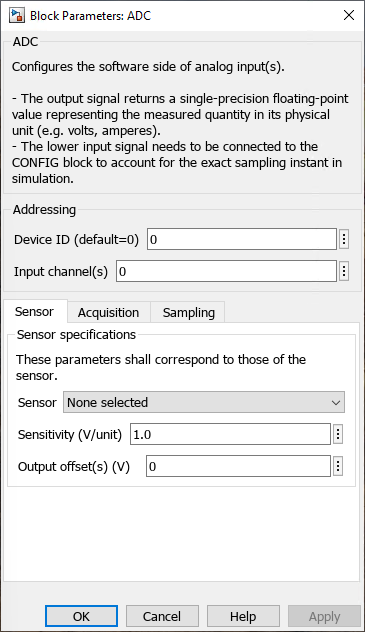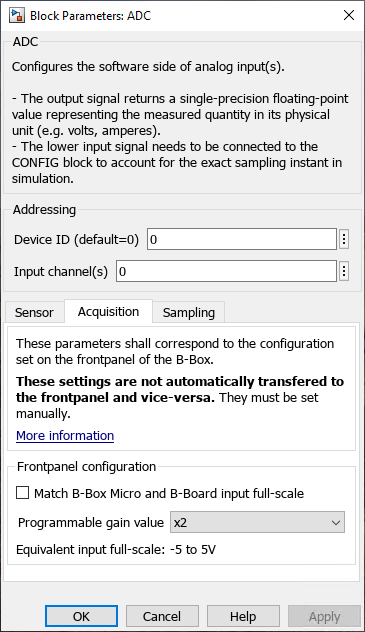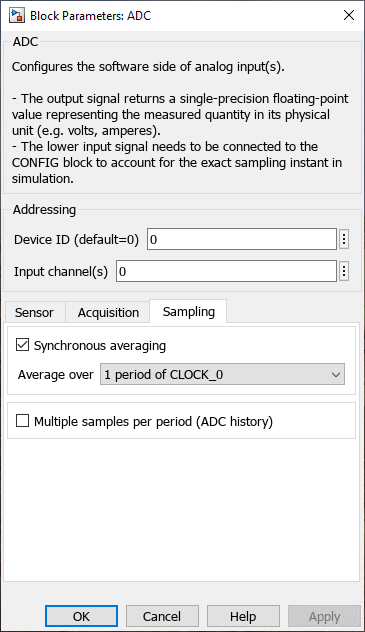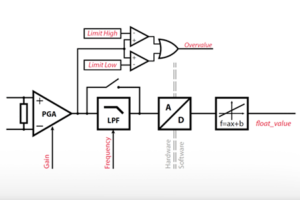Table of Contents
The ADC block is used to retrieve the measurements from the analog inputs of an imperix controller.
This help documentation deals with the software part of the analog data acquisition. To set-up the hardware part, please refer to the following documents:
- Analog front-end configuration on B-Box RCP (PN105)
- B-Box RCP datasheet (PDF)
- B-Board PRO datasheet (PDF)
Simulink block
Signal specification
- The output signal returns a single-precision floating-point value representing the measured quantity in its physical unit (e.g. Volts, Amperes).
- The
siminput signal is used in simulation and documented in Simulation essentials with Simulink (PN135). - The
>input signal needs to be connected to the CONFIG block in order to account for the exact sampling instant in simulation.
Parameters
- Device ID selects which B-Box/B-Board to address when used in a multi-device configuration.
- Input channel(s) (vectorizable) selects which physical input channel to read from (e.g. 0 to 15 on B-Box RCP).
- Sensor
- Sensitivity (vectorizable) is the sensor sensitivity in Volts per measured unit (e.g. V/V for a voltage sensor and V/A for a current sensor).
- Output offset(s) (vectorizable) compensates for the sensor offset. It is expressed in Volts at the output of the sensor.
- Acquisition
- Programmable gain value must match the configuration set on the frontpanel of the B-Box.
- Match B-Box Micro and B-Board input full-scale must be checked if the device is a B-Box Micro B-Board PRO. It forces the programmable analog gain to x2, to account for the +/- 5V input full-scale (as opposed to +/- 10V on the B-Box RCP).
- Sampling
- Synchronous averaging configures the block to output the average ADC value over 1 or 2 periods of CLOCK_0. See Synchronous averaging (PN124) for more details.
- Multiple samples per period (ADC history) configures the block to output a vector of the N last values, as documented in Oversampling (PN154). This option is mutually exclusive with the synchronous averaging.
PLECS block
Signal specification
- The output signal returns a single-precision floating-point value representing the measured quantity in its physical unit (e.g. Volts, Amperes).
- The target inport (only visible at the atomic subsystem level) is used in simulation and documented in Simulation essentials with PLECS (PN137).
- The
>input signal needs to be connected to the CONFIG block to account for the exact sampling instant in simulation.
Parameters
- Addressing
- Device ID selects which B-Box/B-Board to address when used in a multi-device configuration.
- Input channel (vectorizable) selects which physical input channel to read from (e.g. 0 to 15 on B-Box RCP).
- Sensor and Acquisition parameters
- Use/load sensor parameters loads the parameters of an imperix sensor.
- Sensor sensitivity (vectorizable) is the sensor sensitivity in Volts per measured unit (e.g. V/V for a voltage sensor and V/A for a current sensor).
- Sensor output offset (vectorizable) compensates for the sensor offset. It is expressed in Volts at the output of the sensor.
- Programmable gain value must match the configuration set on the frontpanel of the B-Box RCP. If the device is a B-Box Micro or a B-Board PRO, it must be set to x2, to account for the +/- 5V input full-scale (as opposed to +/- 10V on the B-Box RCP).
- Simulate sensor(s) sensitivity(ies): when true, the ADC block expects its input to be the value of the sensor’s output (typ. ±10V). When false, it expects the physical measure value.
- Sampling
- Synchronous averaging configures the block to output the average ADC value over 1 or 2 periods of CLOCK_0. See Synchronous averaging (PN124) for more details.
- Multiple samples per period (ADC history) configures the block to output a vector of the N last values, as documented in Oversampling (PN154). This option is mutually exclusive with the synchronous averaging.
C++ functions
ConfigureMainInterrupt function as explained in the related note: Interrupt configuration.Standard functions
Advanced functions for oversampling
These functions are used to perform oversampling, read Oversampling (PN154) to learn more.
Example of use
sensors.hThis example considers the current sensor of a PEB8024 module. Its sensitivity is \(S=50.0\,[\text{mV/A}]\). As recommended in the datasheet, the chosen front-end gain is selected as \(G= 2\). Considering that the ADC offers 16 bits over the ±10V input range, this results in a total sensitivity \(\alpha = S\cdot G\cdot 32768/10=327.68\,[\text{bit/A}]\).
In this example, gain must therefore be equal to \(\mathtt{gain}=1/\alpha=3.052\,[\text{mA/bit}]\). The offset value can be adjusted empirically to cancel the measured value when no current is flowing through the sensor (static offset).
#define ADCONV (32768.0/10.0) // +/- 10V input range, 16-bit ADC
#define SENSITIVITY (0.05*2*ADCONV) // total sensitivity
#define I_GAIN (1.0/SENSITIVITY )
float I_meas = 0;
tUserSafe UserInit(void)
{
Adc_ConfigureInput(0, I_GAIN, 0.0);
return SAFE;
}
tUserSafe UserInterrupt(void)
{
I_meas = Adc_GetValue(0);
return SAFE;
}Code language: C++ (cpp)











